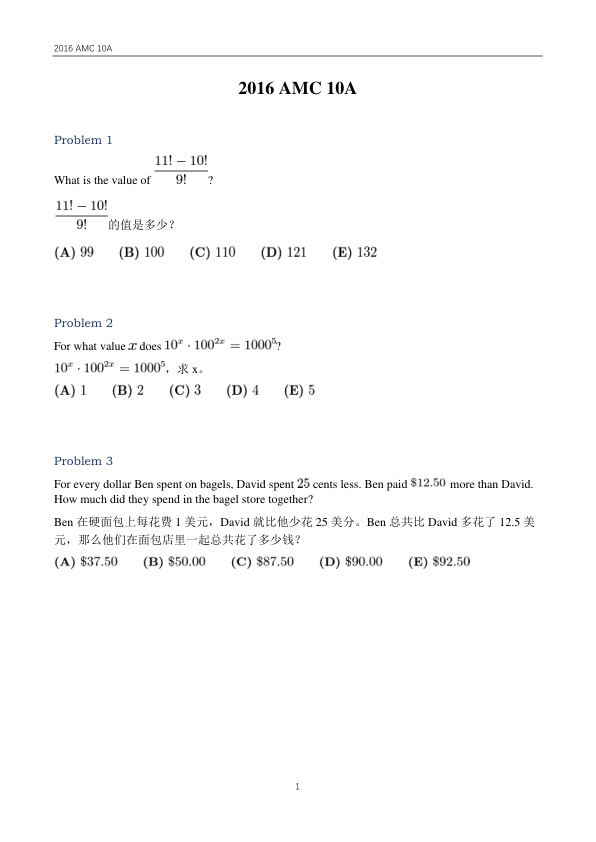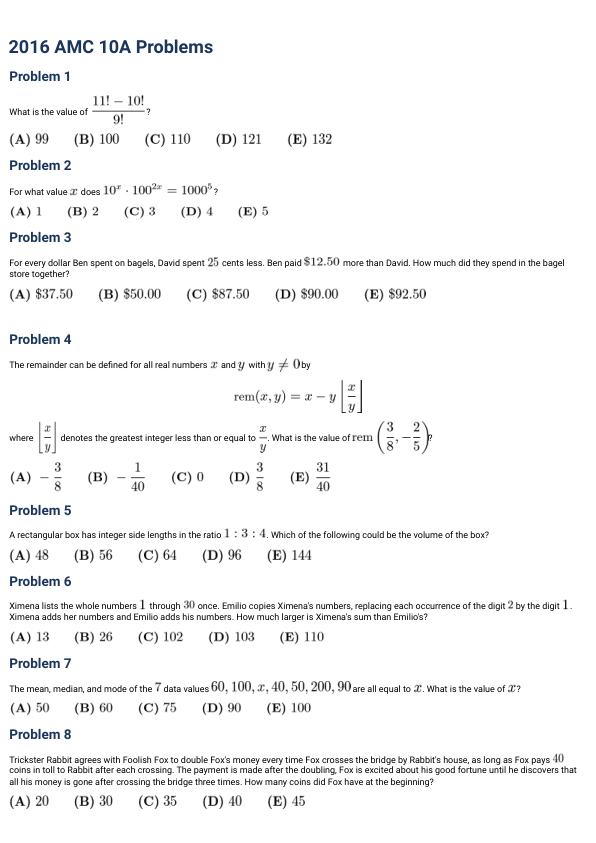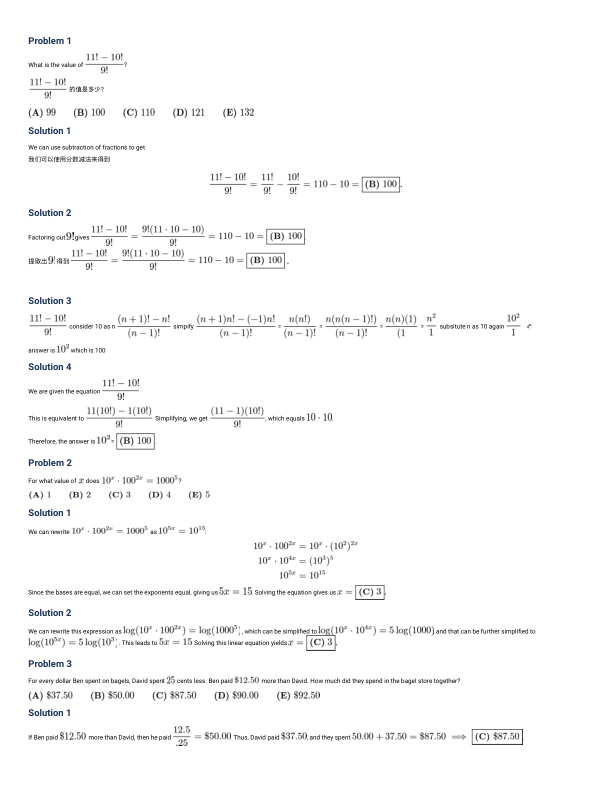2016 AMC amc10a 真题 答案 详解
| 序号 | 文件列表 | 说明 | ||
|---|---|---|---|---|
| 1 | 2016-amc10a-paper-eng-zh.pdf | 10 页 | 488.73KB | 中英双语真题 |
| 2 | 2016-amc10a-paper-eng.pdf | 4 页 | 207.81KB | 英文真题 |
| 3 | 2016-amc10a-key.pdf | 1 页 | 10.08KB | 真题答案 |
| 4 | 2016-amc10a-solution-eng.pdf | 28 页 | 2.52MB | 真题文字详解(英文) |
| 5 | 2016-amc10a-solution-eng-zh.pdf | 28 页 | 2.52MB | 真题文字详解(中英双语) |
| 6 | 2016-amc10a-solution-video-zh.mp4 | 41.58 分钟 | 154.93MB | 真题视频详解(普通话) |
中英双语真题
2016 AMC 10A
Problem 1
What is the value of (\frac{11! - 10!}{9!})?
(\frac{11! - 10!}{9!}) 的值是多少?
(A) 99 (B) 100 (C) 110 (D) 121 (E) 132
Problem 2
For what value (x) does (10^x \cdot 100^{2x} = 1000^5)?
(10^x \cdot 100^{2x} = 1000^5),求 (x)。
(A) 1 (B) 2 (C) 3 (D) 4 (E) 5
Problem 3
For every dollar Ben spent on bagels, David spent 25 cents less. Ben paid $12.50 more than David. How much did they spend in the bagel store together?
Ben 在硬面包上每花费 1 美元,David 就比他少花 25 美分。Ben 总共比 David 多花了 12.5 美元,那么他们在面包店里一起总共花了多少钱?
(A) $37.50 (B) $50.00 (C) $87.50 (D) $90.00 (E) $92.50

英文真题
2016 AMC 10A Problems
Problem 1
What is the value of (\frac{11! - 10!}{9!})?
(A) 99 (B) 100 (C) 110 (D) 121 (E) 132
Problem 2
For what value (x) does (10^x \cdot 100^{2x} = 1000^5)?
(A) 1 (B) 2 (C) 3 (D) 4 (E) 5
Problem 3
For every dollar Ben spent on bagels, David spent 25 cents less. Ben paid $12.50 more than David. How much did they spend in the bagel store together?
(A) $37.50 (B) $50.00 (C) $87.50 (D) $90.00 (E) $92.50
Problem 4
The remainder can be defined for all real numbers (x) and (y) with (y \neq 0) by
[ \text{rem}(x,y) = x - y \left\lfloor \frac{x}{y} \right\rfloor ]
where (\left\lfloor \frac{x}{y} \right\rfloor) denotes the greatest integer less than or equal to (\frac{x}{y}). What is the value of (\text{rem}\left( \frac{3}{8}, -\frac{2}{5} \right))?
(A) (-\frac{3}{8}) (B) (-\frac{1}{40}) (C) 0 (D) (\frac{3}{8}) (E) (\frac{31}{40})
Problem 5
A rectangular box has integer side lengths in the ratio (1:3:4). Which of the following could be the volume of the box?
(A) 48 (B) 56 (C) 64 (D) 96 (E) 144
Problem 6
Ximena lists the whole numbers (1) through (30) once. Emilio copies Ximena's numbers, replacing each occurrence of the digit (2) by the digit (1). Ximena adds her numbers and Emilio adds his numbers. How much larger is Ximena's sum than Emilio's?
(A) 13 (B) 26 (C) 102 (D) 103 (E) 110
Problem 7
The mean, median, and mode of the (7) data values (60, 100, x, 40, 50, 200, 90) are all equal to (x). What is the value of (x)?
(A) 50 (B) 60 (C) 75 (D) 90 (E) 100
Problem 8
Trickster Rabbit agrees with Foolish Fox to double Fox's money every time Fox crosses the bridge by Rabbit's house, as long as Fox pays (40) coins in toll to Rabbit after each crossing. The payment is made after the doubling. Fox is excited about his good fortune until he discovers that all his money is gone after crossing the bridge three times. How many coins did Fox have at the beginning?
(A) 20 (B) 30 (C) 35 (D) 40 (E) 45

真题文字详解(英文)
Problem 1 What is the value of \frac{11! - 10!}{9!}?
(A) 99 (B) 100 (C) 110 (D) 121 (E) 132
Solution 1 We can use subtraction of fractions to get \frac{11! - 10!}{9!} = \frac{11!}{9!} - \frac{10!}{9!} = 110 - 10 = (B) 100.
Solution 2 Factoring out 9! gives \frac{11! - 10!}{9!} = \frac{9!(11\cdot10-10)}{9!} = 110 - 10 = (B) 100.
Solution 3 \frac{11! - 10!}{9!} consider 10 as n \frac{(n+1)! - n!}{(n-1)!} simplify \frac{(n+1)n! - (-1)n!}{(n-1)!} = \frac{n(n!) - n(n-1)!}{(n-1)!} = \frac{n(n)(1)}{(n-1)!} = \frac{n^2}{1} substitute n as 10 again \frac{10^2}{1} answer is 10^2 which is 100
Solution 4 We are given the equation \frac{11! - 10!}{9!} This is equivalent to \frac{11(10!) - 1(10!)}{9!} Simplifying, we get \frac{(11-1)(10!)}{9!}, which equals 10\cdot10. Therefore, the answer is 10^2 = (B) 100.
Problem 2 For what value of x does 10^x · 100^{2x} = 1000^5?
(A) 1 (B) 2 (C) 3 (D) 4 (E) 5
Solution 1 We can rewrite 10^x · 100^{2x} = 1000^5 as 10^{5x} = 10^{15}. 10^x · 10^{4x} = (10^3)^5 10^{5x} = 10^{15} Since the bases are equal, we can set the exponents equal, giving us 5x = 15. Solving the equation gives us x = (C) 3.
Solution 2 We can rewrite this expression as log(10^x · 100^{2x}) = log(1000^5), which can be simplified to log(10^x · 10^{4x}) = 5 log(1000), and that can be further simplified to log(10^{5x}) = 5 log(10^3). This leads to 5x = 15. Solving this linear equation yields x = (C) 3.
Problem 3 For every dollar Ben spent on bags, David spent 25 cents less. Ben paid $12.50 more than David. How much did they spend in the bagel store together?
(A) $37.50 (B) $50.00 (C) $87.50 (D) $90.00 (E) $92.50
Solution 1 If Ben paid $12.50 more than David, then he paid \frac{12.5}{.25} = $50.00. Thus, David paid $37.50, and they spent 50.00 + 37.50 = $87.50 => (C) $87.50.
Solution 2 If for every dollar Ben spent on bagels David spent 25 cents less, then the ratio of the money that Ben spent to David spent is 4 : 3. We know that Ben paid $12.50 more than David, so we can write $12.50 · (4 + 3) = $87.50. Then the answer is (C).
Problem 4

真题文字详解(中英双语)
Problem 1 What is the value of \frac{11! - 10!}{9!}? \frac{11! - 10!}{9!} 的值是多少? (A) 99 (B) 100 (C) 110 (D) 121 (E) 132 Solution 1 We can use subtraction of fractions to get \frac{11! - 10!}{9!} = \frac{11!}{9!} - \frac{10!}{9!} = 110 - 10 = (B) 100. 我们可以使用分数减法来得到 \frac{11! - 10!}{9!} = \frac{11!}{9!} - \frac{10!}{9!} = 110 - 10 = (B) 100.
Solution 2 Factoring out 9! gives \frac{11! - 10!}{9!} = \frac{9!(11 \cdot 10 - 10)}{9!} = 110 - 10 = (B) 100. 提取出 9! 得到 \frac{11! - 10!}{9!} = \frac{9!(11 \cdot 10 - 10)}{9!} = 110 - 10 = (B) 100.
Solution 3 \frac{11! - 10!}{9!} consider 10 as n \frac{(n+1)! - n!}{(n-1)!} simplify \frac{(n+1)n! - (-1)n!}{(n-1)!} = \frac{n(n!)}{(n-1)!} = \frac{n(n)(1)}{(n-1)!} = \frac{n^2}{1} substitute n as 10 again \frac{10^2}{1} answer is 10^2 which is 100 Solution 4 We are given the equation \frac{11! - 10!}{9!} This is equivalent to \frac{11(10!) - 1(10!)}{9!} Simplifying, we get \frac{(11-1)(10!)}{9!}, which equals 10 \cdot 10. Therefore, the answer is 10^2 = (B) 100.
Problem 2 For what value of x does 10^x \cdot 100^{2x} = 1000^5? (A) 1 (B) 2 (C) 3 (D) 4 (E) 5 Solution 1 We can rewrite 10^x \cdot 100^{2x} = 1000^5 as 10^x \cdot (10^2)^{2x} = 10^x \cdot 10^{4x} = (10^3)^5 = 10^{15}. Since the bases are equal, we can set the exponents equal, giving 5x = 15. Solving the equation gives us x = (C) 3.
Solution 2 We can rewrite this expression as log(10^x \cdot 100^{2x}) = log(1000^5), which can be simplified to log(10^x \cdot 10^{4x}) = 5 log(1000), and that can be further simplified to log(10^{5x}) = 5 log(10^3). This leads to 5x = 15. Solving this linear equation yields x = (C) 3.
Problem 3 For every dollar Ben spent on bags, David spent 25 cents less. Ben paid $12.50 more than David. How much did they spend in the bagel store together? (A) $37.50 (B) $50.00 (C) $87.50 (D) $90.00 (E) $92.50 Solution 1 If Ben paid $12.50 more than David, then he paid \frac{12.5}{.25} = $50.00. Thus, David paid $37.50, and they spent $50.00 + $37.50 = $87.50 => (C) $87.50.

